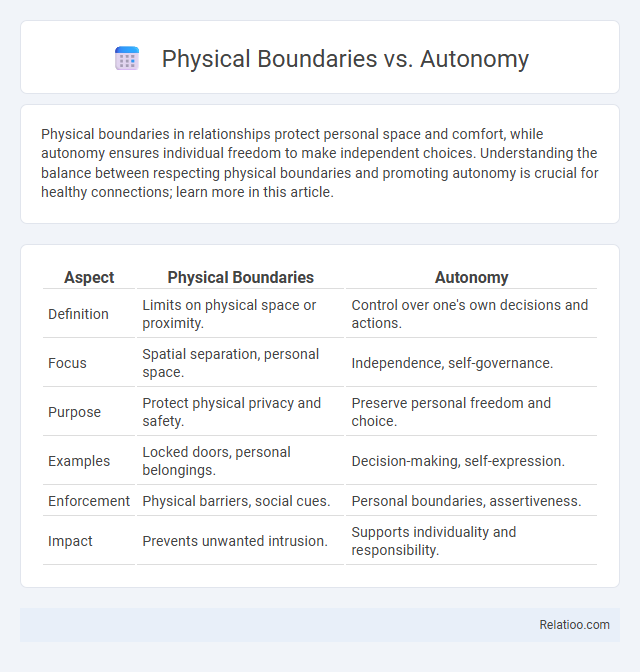Physical boundaries in relationships protect personal space and comfort, while autonomy ensures individual freedom to make independent choices. Understanding the balance between respecting physical boundaries and promoting autonomy is crucial for healthy connections; learn more in this article.
Table of Comparison
| Aspect | Physical Boundaries | Autonomy |
|---|---|---|
| Definition | Limits on physical space or proximity. | Control over one's own decisions and actions. |
| Focus | Spatial separation, personal space. | Independence, self-governance. |
| Purpose | Protect physical privacy and safety. | Preserve personal freedom and choice. |
| Examples | Locked doors, personal belongings. | Decision-making, self-expression. |
| Enforcement | Physical barriers, social cues. | Personal boundaries, assertiveness. |
| Impact | Prevents unwanted intrusion. | Supports individuality and responsibility. |
Defining Physical Boundaries in Relationships
Defining physical boundaries in relationships is crucial for maintaining personal space and comfort, ensuring both partners respect each other's physical limits. Clear communication about physical boundaries helps prevent misunderstandings and fosters mutual trust while supporting individual autonomy. Establishing these boundaries empowers you to feel safe and valued, balancing closeness with personal freedom.
Understanding Personal Autonomy
Understanding personal autonomy involves recognizing the importance of physical boundaries as essential limits that protect individual independence and self-governance. Autonomy encompasses the capacity to make informed decisions without external coercion, emphasizing control over one's body and environment. Clear physical boundaries reinforce autonomy by safeguarding personal space, promoting respect, and enabling individuals to exercise their rights freely.
Key Differences: Physical Boundaries vs. Autonomy
Physical boundaries refer to the tangible limits that define personal space, such as body contact or proximity, while autonomy centers on an individual's capacity to make independent decisions and control their own life choices. Your physical boundaries protect your immediate environment from unwanted intrusion, whereas autonomy empowers you to govern your actions and preferences freely. Understanding these distinctions allows you to maintain respect for personal space without compromising your self-governance and decision-making freedom.
The Importance of Establishing Physical Boundaries
Establishing physical boundaries is crucial for maintaining personal autonomy and protecting your mental and emotional well-being. Clear physical limits help prevent unwanted intrusions, reduce stress, and reinforce your sense of control over your environment. Prioritizing these boundaries supports healthier relationships and fosters mutual respect between individuals.
How Autonomy Supports Healthy Relationships
Autonomy fosters healthy relationships by allowing individuals to maintain personal boundaries while engaging in mutual respect and trust. Establishing clear physical boundaries reinforces autonomy, ensuring that partners feel secure and valued without feeling controlled or restricted. This balance between autonomy and boundaries encourages open communication, emotional independence, and deeper connection.
Common Challenges in Balancing Boundaries and Autonomy
Balancing physical boundaries and personal autonomy often presents challenges related to maintaining individual freedom while respecting others' space. Common issues include negotiating privacy needs, managing overlapping responsibilities, and preventing boundary violations in both personal and professional relationships. Effective communication and clear agreement on limits are essential for harmonizing autonomy with respectful boundary-setting.
Respecting Physical Space: Practical Guidelines
Respecting physical boundaries ensures personal comfort and safety, reinforcing autonomy by allowing individuals to control their own space. You can establish clear, respectful physical boundaries by communicating your needs assertively and observing others' nonverbal cues. Practical guidelines include maintaining appropriate distance, asking for permission before physical contact, and acknowledging when someone expresses discomfort or requires privacy.
Signs of Overstepping Physical Boundaries
Signs of overstepping physical boundaries include unwanted touching, invading personal space without consent, and ignoring verbal or non-verbal cues indicating discomfort. Such behavior undermines individual autonomy by disregarding a person's right to control their own body. Recognizing these signs is essential to maintaining respect and fostering healthy interpersonal relationships.
Strategies to Foster Autonomy While Maintaining Boundaries
Setting clear physical boundaries is essential for maintaining personal space, while fostering autonomy encourages self-direction and independence. Strategies to achieve this balance include open communication about needs, consistent enforcement of limits, and encouraging decision-making within established boundaries. You can promote autonomy by allowing choice and responsibility, ensuring that personal boundaries are respected to support healthy relationships and personal growth.
Building Mutual Respect Through Communication
Setting clear physical boundaries fosters a sense of safety and respect in any relationship, while autonomy emphasizes individual freedom and personal space. Your ability to communicate openly about these boundaries enhances mutual understanding and trust, creating a balanced environment where both parties feel valued. Effective dialogue ensures that respect for physical space and personal autonomy coexist harmoniously, strengthening the relationship's foundation.

Infographic: Physical Boundaries vs Autonomy
 relatioo.com
relatioo.com